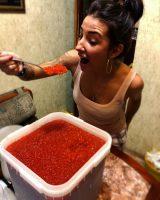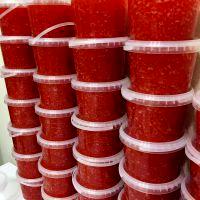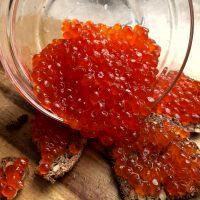Red Caviar How To Choose?
The question of how to choose the right caviar is very relevant before the New Year holidays. Well, it’s time to figure it out!
Red caviar is harvested from fish of salmon (chum salmon, pink salmon, trout, coho salmon). The product is rich in vitamins A, D and E, easily digestible proteins (up to 32% in composition), phosphorus, polyunsaturated fatty acids. Also in the composition: iodine, calcium, potassium and iron, folic acid and other nutrients necessary for immunity, youth and strength. Enough small amount!
Doctors consider caviar to be the most valuable food. The main thing is to know which caviar is better to choose and how to recognize a fake. It is very important. After all, instead of the royal delicacy you can buy an imitation. For the same money …
Detailed material on how to choose red fish, look here.
We study the information on the package
Granular caviar is made from raw caviar of Pacific (Far Eastern) salmon: pink salmon, chum salmon, coho salmon, sockeye salmon. In the production of raw processed salt solution with the subsequent addition of preservatives (or without them).
Caviar is of the first and second grade.
Grades of red caviar
Indicator
Norm for variety
Red caviar 1 grade
Red caviar 2nd grade
Appearance
Caviar of one type of fish. Eggs are clean, whole, uniform in color, without films and blood clots.
– the insignificant quantity of covers is allowed
– the presence of shell;– color heterogeneity;
– slight precipitate.
Consistency
Eggs are elastic, with a slightly wet or dry surface, well separated and do not stick.
– may be more wet, slightly less elastic;
– may be slightly viscous.
Smell
Characteristic of the product of this type, without odors.
Mass fraction of salt,%
4 – 6
4 – 7
Taste
Peculiar to a product, without foreign taste. A slight bitterness (for caviar of salmon, salmon) and spice is allowed.
Composition of red caviar (read on the package)
There should be three rows of signs on the lid:
The figures on the bank of high-quality caviar are pressed from inside or applied with a laser with indelible paint. Sold outside, smeared – a sign of a fake!
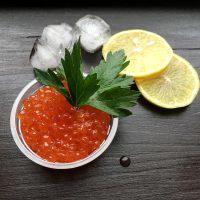
Good Salmon Caviar
Where and when is caviar packed?
It is best of all if caviar packaging was carried out near the place of its extraction and production.
Caviar of pink salmon, chum salmon, coho salmon, sockeye salmon, trout
What caviar to choose – you decide. If the product is quality, you will not be disappointed in any way.
Signs of good caviar
How to choose a good quality red caviar?

Red Caviar
Signs of a fake
No less important to know and signs of a fake. Here they are:
As for artificial caviar, it is impossible to call it harmful, but its value for the organism is also not great. The product is made from protein, gelatin, milk and eggs. There are no vitamins and beneficial fatty acids in its composition – it is definitely not worth buying one for the price of natural.
Type of packaging: glass or can, by weight, in plastic containers
How to choose a jar of red caviar? What to prefer: tin, plastic, glass?
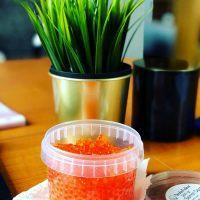
Red Caviar Calories
In short, tin and glass are in priority.
And finally. Store the product in the refrigerator, observing the shelf life. It is better not to keep an open can for a long time – no more than 5 days. Freezing caviar also makes no sense – it will lose not only taste, but also its beneficial properties. Appearance will also suffer.
Optimally: bought – ate. Happy holidays!
